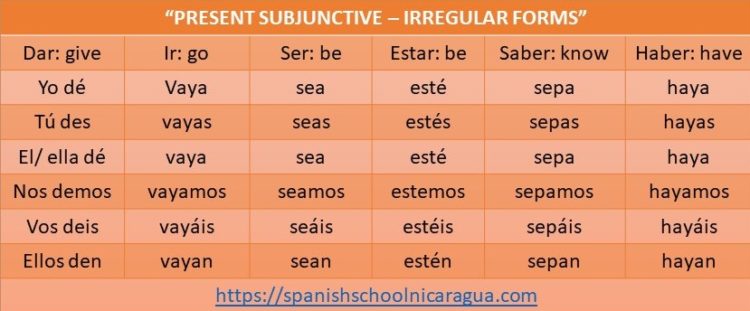Present Subjunctive Spanish is formed by attaching the following endings to the stem of the first person singular of the present indicative of regular and irregular verbs. The personal ending O is dropped. To the root are added the personal endings of the subjunctive. You will note that the personal endings of the present subjunctive Spanish are the reverse of those used for the indicative. The vowel e is used for AR verbs and the vowel a is used for ER and IR verbs. Since the first and third-person singular forms of the present subjunctive are identical, subject pronouns are used when necessary to avoid ambiguity.
-
- AR verbs: e, es, e, emos, en
- ER verbs: a, as, a, amos, an
- IR verbs: a, as, a, amos, an
Present Subjunctive Spanish Regular Forms
Amar: to love Comer: to eat Escribir: to write
Yo ame coma escriba
Tu ames comas escribas
El/ ella ame coma escriba
Nos amemos comamos escribamos
Ellos amen coman escriban
All the verbs whose present indicative yo form does not end in -o have irregular present subjunctive forms. (dar, estar, ir, saber, ser)
Some verbs like “Decir” and “Escribir”, can either transmit information or convey a request. When information is transmitted, the indicative is used in the subordinate clauses, when a request is conveyed, the subjunctive is used in the subordinate clause.
Information:
Ella les dice que van a trabajar. She tells them that they are going to work.
Request:
Ella les dice que vayan a trabajar. She tells them to go to work.
As you know, the subjunctive occurs in subordinate clauses only when the main clause communicates certain messages. One of these is persuasion: a request that someone else do something. The action that may or may not occur as a result of the request is expressed with the subjunctive because it is outside the speaker’s experience or reality.
Irregular forms
There are six irregular verbs in the Present Subjunctive.
